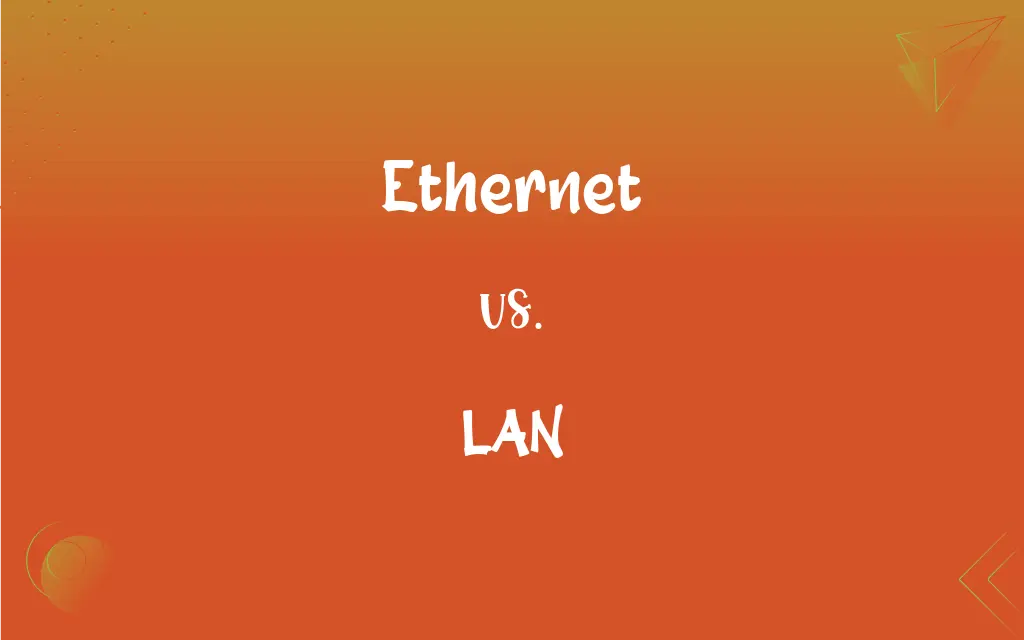Ethernet vs. LAN: What's the Difference?
Edited by Aimie Carlson || By Janet White || Published on February 22, 2024
Ethernet is a technology for connecting devices in a wired network, whereas LAN (Local Area Network) is a network covering a small geographic area, using various technologies including Ethernet.

Key Differences
Ethernet is a specific technology used for interconnecting devices in a network, primarily designed for local area networks (LANs). LAN, on the other hand, is a broader concept referring to a network that spans a relatively small area, typically a single building or campus. Ethernet is one of the most common technologies used in LANs, but a LAN can use various other technologies too.
Ethernet uses specific protocols and cable types (like CAT5, CAT6) to connect devices within a network. It's known for its role in enabling devices to communicate within a LAN. LAN encompasses not just the physical connections (like Ethernet) but also includes wireless connections, defining a network's geographical and technological boundaries rather than its physical infrastructure alone.
Ethernet is characterized by its method of network access (CSMA/CD) and its physical and data link layer specifications in the OSI model. LAN, however, is defined by its size and scope, not restricted to any specific technology or method of data transmission. LANs can be built using Ethernet, Wi-Fi, or other data transmission methods.
Ethernet was developed in the 1970s and standardized in the 1980s, focusing on improving speed and reliability in connecting multiple devices in close proximity. LAN as a concept predates Ethernet, encompassing any network confined to a small area, whether using Ethernet, token ring, or other networking technologies.
Ethernet is often used as the backbone for most modern LANs, providing high-speed, reliable connections. LAN refers to the overall network within a limited area, which can be a home, office, or campus, where Ethernet is a key component but not the only method for creating such a network.
ADVERTISEMENT
Comparison Chart
Definition
A technology for network connectivity using cables and protocols.
A network covering a small geographic area.
Scope
Specific to physical and data link layers.
Encompasses entire network architecture in a small area.
Technology
Uses twisted pair, coaxial cables, or fiber optics.
Can use Ethernet, Wi-Fi, or other technologies.
Function
Facilitates device-to-device communication within a network.
Connects a group of computers and devices in a small area.
Use Case
Commonly used for wired connections in a LAN.
Includes both wired (Ethernet) and wireless networks.
ADVERTISEMENT
Ethernet and LAN Definitions
Ethernet
Ethernet is a network technology for wired data transfer in local area networks.
The office computers are connected via Ethernet for faster data transfer.
LAN
A LAN (Local Area Network) is a network that connects computers within a limited area.
The school's computers are all part of a single LAN for easy file sharing.
Ethernet
Ethernet operates at the physical and data link layers of the OSI model.
When setting up a network, understanding Ethernet is crucial for the physical setup.
LAN
LANs are typically used for connecting devices in homes, offices, or schools.
Our office's LAN allows for seamless communication between different departments.
Ethernet
Ethernet uses cables and a set of protocols for network communication.
Our new printer needs to be connected to the Ethernet to join the network.
LAN
A LAN can be wired, wireless, or a combination of both.
The new library features a LAN that includes both Ethernet and Wi-Fi connectivity.
Ethernet
Ethernet is characterized by its frame format and CSMA/CD access method.
The Ethernet technology in our LAN ensures efficient data transmission among devices.
LAN
LANs are known for high data transfer speeds and low latency.
The LAN in our gaming café offers exceptionally fast internet speeds for gamers.
Ethernet
Ethernet is a wired networking standard known for its speed and reliability.
For secure and fast internet access, the company relies on an Ethernet connection.
LAN
LANs are useful for sharing resources like files, printers, and internet access.
All employees can print documents through the LAN-connected shared printer.
Ethernet
Alternative case form of Ethernet
LAN
A system that links together electronic office equipment, such as computers and printers, and forms a network within an office, building, or group of buildings
Ethernet
A type of networking technology for local area networks; coaxial cable carries radio frequency signals between computers at a rate of 10 megabits per second
LAN
A local area network; a network{3} connecting computers and word processors and other electronic office equipment within a small area, to create an inter-office system, typically within one building or one site of a corporation. Contrasted to WAN, a wide-area network.
LAN
A local computer network for communication between computers; especially a network connecting computers and word processors and other electronic office equipment to create a communication system between offices
FAQs
What is Ethernet?
Ethernet is a technology for connecting devices in a network, mainly used for wired local area networks.
What is the maximum length for an Ethernet cable?
The maximum recommended length for a standard Ethernet cable is 100 meters.
How does a LAN differ from a WAN?
A LAN is limited to a small area like a building, while a WAN (Wide Area Network) covers a broader geographic area.
Can Ethernet be used for networks other than LANs?
Ethernet is primarily designed for LANs but can be adapted for larger networks through devices like routers and switches.
Are LANs always wired?
No, LANs can be either wired, wireless, or a combination of both.
Is Ethernet still relevant with wireless technology?
Yes, Ethernet is often preferred for its stability and high speed, especially in business environments.
What are the common speeds of Ethernet connections?
Ethernet speeds vary, with common standards being 10 Mbps, 100 Mbps, 1 Gbps, and 10 Gbps.
What does LAN stand for?
LAN stands for Local Area Network, referring to a network in a small geographic area.
Can different technologies be used within a single LAN?
Yes, a LAN can include a mix of technologies like Ethernet, Wi-Fi, and others.
Is setting up a LAN complicated?
Setting up a basic LAN is relatively straightforward, but complexity can increase with the network's size and requirements.
Are all LANs private networks?
Most LANs are private, but they can also be part of public networks, especially in places like libraries or cafes.
What is a common use of Ethernet in a home setting?
Ethernet is commonly used to connect devices like PCs, gaming consoles, and smart TVs for stable internet access.
What is the main benefit of a LAN?
A LAN facilitates fast and secure data transfer and resource sharing within a limited area.
How secure is a LAN?
LANs can be very secure, especially with proper network management and security measures.
Are Ethernet cables expensive?
Ethernet cables are generally affordable and widely available.
Do all Ethernet cables offer the same speed?
No, Ethernet cables come in different categories (like Cat5, Cat6) with varying speed and bandwidth capacities.
Can a LAN exist without the internet?
Yes, a LAN can function for local file and resource sharing without an internet connection.
Can Ethernet support voice and video transmission?
Yes, Ethernet can efficiently handle voice, video, and data transmission.
Is Ethernet compatible with all operating systems?
Ethernet is widely compatible with most operating systems, provided the device has an Ethernet port.
What is the role of a router in a LAN?
A router is used to connect multiple networks and direct network traffic efficiently in a LAN.
About Author
Written by
Janet WhiteJanet White has been an esteemed writer and blogger for Difference Wiki. Holding a Master's degree in Science and Medical Journalism from the prestigious Boston University, she has consistently demonstrated her expertise and passion for her field. When she's not immersed in her work, Janet relishes her time exercising, delving into a good book, and cherishing moments with friends and family.
Edited by
Aimie CarlsonAimie Carlson, holding a master's degree in English literature, is a fervent English language enthusiast. She lends her writing talents to Difference Wiki, a prominent website that specializes in comparisons, offering readers insightful analyses that both captivate and inform.































































